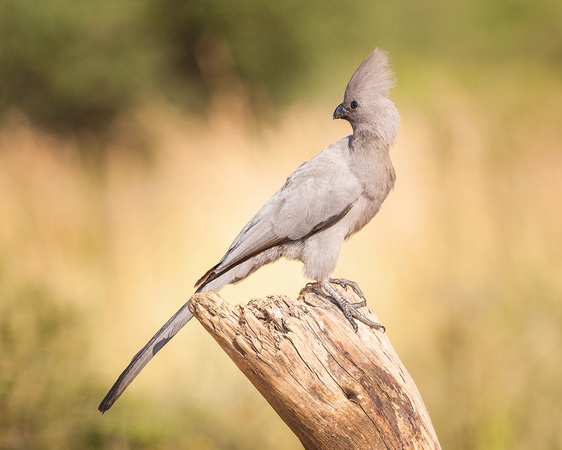Grey Loerie (Corythaixoides concolor)
Grey Loerie (Corythaixoides concolor)
20 inches long.
The grey go-away-bird, also known as grey lourie, grey loerie, or kwêvoël, is a southern African turaco of uniform grey with black beak and strikingly pink gape. It can be found in the dry open savanna woodlands of Angola, Zambia, south eastern parts of the Democratic Republic of the Congo (formerly Zaire), Malawi and South-East Tanzania to Namibia, North-east Botswana, Zimbabwe, Mozambique and North-east South Africa.
The habitat it occupies is dry open savanna woodlands, farms, parks, and suburban gardens, often near water. It is a clumsy flier though extremely agile in clambering through tree crowns. Usually seen in small parties.
The go-away bird gets its name from its well-known call, a harsh loud alarm call "kay-waaay,“ or “quare” or fancifully sounding like "go away“, which warns other birds of a human's presence. It often follows the hunter and thus alarms the animals that he is hunting. The crest is raised when excited.
Its diet is mainly fruit (such as wild figs and berries), flowers, buds, leaves, termites, and snails. It may even eat small birds.
The nest is a flat, flimsy platform of interlaced twigs. It is typically placed 9-30 feet above ground in a thorny tree. In a survey of of 128 different nests, 95 were in thorny trees, 18 were in non-thorny trees, 12 were in clumps of mistletoe and 3 were in matted creepers.
Egg-laying season is year-round, peaking from September-October. It lays 1-4, usually 2-3 eggs which are incubated by both sexes for 26-29 days. The incubating bird is very difficult to scare out of its position. In one situation, the nest was covered in smoke from a grass fire at the base of the tree, but the incubating bird did not fly off!
Photographed in Madikwe Game Reserve, North West, South Africa.


